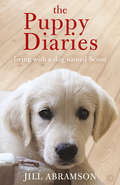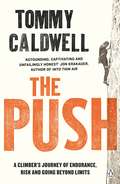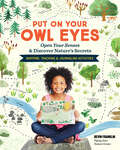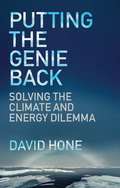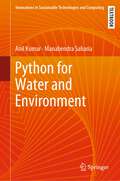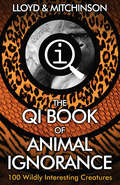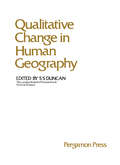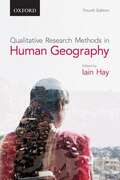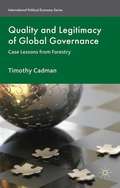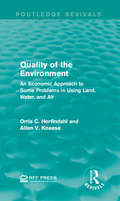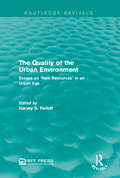- Table View
- List View
The Puppy Diaries: Living With a Dog Named Scout
by Jill AbramsonOne sparkling summer day, Jill Abramson brought home a nine-week-old golden retriever named Scout. Over the following year, as she and her husband raised their adorable new puppy, Abramson wrote a hugely popular column for The New York Times's website about the joys and challenges of training this rambunctious addition to their family. Dog-lovers from across the country inundated her with emails and letters, and the photos they sent in of their own dogs became the most visited photo album on the Times's site in 2009. Now, Abramson has gone far beyond the material in her column and written a detailed and deeply personal account of Scout's first year. Part memoir, part manual, part investigative report, The Puppy Diaries continues Abramson's intrepid reporting on all things canine. Along the way, she weighs in on such issues as breeders or shelters, adoption or rescue, raw diet or vegan, pack-leader gurus like Cesar Millan or positive-reinforcement advocates like Karen Pryor. What should you expect when a new puppy enters your life? With utterly winning stories and a wealth of practical information, The Puppy Diaries provides an essential road map for navigating the first year of your dog's life.
Purity of Blood: The Adventures of Captain Alatriste (The Adventures of Captain Alatriste)
by Arturo Perez-ReverteThe second 'Captain Alatriste' novel, from a series which has sold 4 million copies worldwideA woman has been found in a sedan chair in front of a church, strangled. In her hand is a pouch containing fifty escudos and a handwritten - but unsigned - note bearing the words 'For masses for her soul'. The chief constable Martin Saldana confides in his old friend and comrade in arms, Diego Alatriste. Still in danger from the powerful enemies he made in his first adventure, Captain Alatriste is considering returning to Flanders where the war has just resumed. But first, his old friend Quevedo asks him for a favour. The daughter of one of his friends must be rescued from a convent, which certain 'priests' seem to be treating as little more than a harem. Then the woman who brought the girl to the convent goes missing and the connection is made to the murder at the church. It seems that Alatriste's sword is required once more.
Pursuing Sustainability: A Guide to the Science and Practice
by Pamela Matson William C. Clark Krister AnderssonSustainability is a global imperative and a scientific challenge like no other. This concise guide provides students and practitioners with a strategic framework for linking knowledge with action in the pursuit of sustainable development, and serves as an invaluable companion to more narrowly focused courses dealing with sustainability in particular sectors such as energy, food, water, and housing, or in particular regions of the world.Written by leading experts, Pursuing Sustainability shows how more inclusive and interdisciplinary approaches and systems perspectives can help you achieve your sustainability objectives. It stresses the need for understanding how capital assets are linked to sustainability goals through the complex adaptive dynamics of social-environmental systems, how committed people can use governance processes to alter those dynamics, and how successful interventions can be shaped through collaborations among researchers and practitioners on the ground.The ideal textbook for undergraduate and graduate students and an invaluable resource for anyone working in this fast-growing field, Pursuing Sustainability also features case studies, a glossary, and suggestions for further reading.Provides a strategic framework for linking knowledge with actionDraws on the latest cutting-edge science and practicesServes as the ideal companion text to more narrowly focused coursesUtilizes interdisciplinary approaches and systems perspectivesIllustrates concepts with a core set of case studies used throughout the bookWritten by world authorities on sustainabilityAn online illustration package is available to professors
Pursuing Sustainability: A Guide to the Science and Practice
by Pamela Matson William C. Clark Krister AnderssonSustainability is a global imperative and a scientific challenge like no other. This concise guide provides students and practitioners with a strategic framework for linking knowledge with action in the pursuit of sustainable development, and serves as an invaluable companion to more narrowly focused courses dealing with sustainability in particular sectors such as energy, food, water, and housing, or in particular regions of the world.Written by leading experts, Pursuing Sustainability shows how more inclusive and interdisciplinary approaches and systems perspectives can help you achieve your sustainability objectives. It stresses the need for understanding how capital assets are linked to sustainability goals through the complex adaptive dynamics of social-environmental systems, how committed people can use governance processes to alter those dynamics, and how successful interventions can be shaped through collaborations among researchers and practitioners on the ground.The ideal textbook for undergraduate and graduate students and an invaluable resource for anyone working in this fast-growing field, Pursuing Sustainability also features case studies, a glossary, and suggestions for further reading.Provides a strategic framework for linking knowledge with actionDraws on the latest cutting-edge science and practicesServes as the ideal companion text to more narrowly focused coursesUtilizes interdisciplinary approaches and systems perspectivesIllustrates concepts with a core set of case studies used throughout the bookWritten by world authorities on sustainabilityAn online illustration package is available to professors
The Push: A Climber's Journey of Endurance, Risk and Going Beyond Limits
by Tommy Caldwell'A real page-turner . . . captivating and deeply moving' Climb magazine In 2015 freeclimber Tommy Caldwell spent 19 days summiting Yosemite's vertical, 3000-foot Dawn Wall - the hardest climb in history. It was the culmination of seven years planning and a lifetime's determination. Here, he recounts how he got there, the falls and set backs (being held hostage, losing his index finger, the break-up of his marriage), the summits conquered and the fears overcome. It is a story about drive, focus and how to achieve the impossible - one toehold at a time. 'Caldwell's story is one of the best. You get more than just a climbing adventure, you get the inside view of how a person can endure crushing setbacks and persist to fulfill a spectacular vision' Jim Collins, author of Good to Great 'Heart-stopping, absorbing' Daily Mail 'Captivating and unfailingly honest' Jon Krakauer 'This isn't just a book about climbing, it's about laser sharp focus in all aspects of life' Scott Jurek, author of Eat & Run 'Absolutely captivating, thrills, enriches' Denver Post
Puss in Books: Our Best-loved Writers On Their Best-loved Cats
by Paul MagrsA charming collection of quotes about cats from our favourite authors, accompanied by artwork in the trademark style of Paul Magrs (author of The Panda, the Cat and the Dreadful Teddy).
Put On Your Owl Eyes: Open Your Senses & Discover Nature's Secrets; Mapping, Tracking & Journaling Activities
by Devin FranklinKids aged 8 to 13 will sharpen their senses and get to know the natural world up close with this guide to nature observation and exploration, including tracking, mapping, and reflective journaling activities.
Putting a Price on Carbon in South Africa and Other Developing Countries (Climate Policy Ser.)
by Harald WinklerHow should we be putting a price on carbon, particularly in developing countries? This volume takes up this contested issue and examines how different economic instruments might apply in developing countries, with a special focus on South Africa. The papers included address a variety of themes in this area: Emissions trading, carbon taxes, fiscal and non-fiscal instruments, policy and institutional dimensions, and lessons from the Clean Development Mechanism. Presenting the very latest research, the volume will be of interest to academics and policymakers in economics, policy and development.
Putting a Price on Carbon in South Africa and Other Developing Countries
by Harald Winkler Andrew MarquardHow should we be putting a price on carbon, particularly in developing countries? This volume takes up this contested issue and examines how different economic instruments might apply in developing countries, with a special focus on South Africa. The papers included address a variety of themes in this area: Emissions trading, carbon taxes, fiscal and non-fiscal instruments, policy and institutional dimensions, and lessons from the Clean Development Mechanism. Presenting the very latest research, the volume will be of interest to academics and policymakers in economics, policy and development.
Putting the Genie Back: Solving the Climate and Energy Dilemma
by David HoneOn November 4th 2016 the Paris Agreement entered into force. The warming of the climate system, first recognized over a century ago, has become one of the key political and social issues of our time. Some still deny it is happening, others are incensed by the slow pace of change, while most are left confused and uncertain not just by the science, but by the panoply of solutions put forward by politicians, business people, academics and activists. At its most ambitious, the Paris Agreement implies a transition within the global energy system such that carbon dioxide emissions fall rapidly from 40 billion tonnes per annum in 2016, to net-zero by the middle of the century. Yet our fossil fuel based energy system which ushered in the Industrial Revolution nearly 200 years ago continues to grow and evolve even as new sources of energy come into the market and compete. The principal economic instrument for change is clear and has been for over two decades, but in 2017 only a fraction of the global economy actively employs government led carbon pricing policies and within that only a handful of systems operate at a level commensurate with the pace and scale of change that is necessary. As deployment of new energy technologies accelerates, can solutions be found to cover the full range of services delivered by fossil fuels and can warming be limited to the agreed global goals? Putting the Genie Back explores the climate issue from its very beginnings through to the end of end of the 21st Century and looks in depth at the transition challenge we collectively face.
Putting the Genie Back: Solving the Climate and Energy Dilemma
by David HoneOn November 4th 2016 the Paris Agreement entered into force. The warming of the climate system, first recognized over a century ago, has become one of the key political and social issues of our time. Some still deny it is happening, others are incensed by the slow pace of change, while most are left confused and uncertain not just by the science, but by the panoply of solutions put forward by politicians, business people, academics and activists. At its most ambitious, the Paris Agreement implies a transition within the global energy system such that carbon dioxide emissions fall rapidly from 40 billion tonnes per annum in 2016, to net-zero by the middle of the century. Yet our fossil fuel based energy system which ushered in the Industrial Revolution nearly 200 years ago continues to grow and evolve even as new sources of energy come into the market and compete. The principal economic instrument for change is clear and has been for over two decades, but in 2017 only a fraction of the global economy actively employs government led carbon pricing policies and within that only a handful of systems operate at a level commensurate with the pace and scale of change that is necessary. As deployment of new energy technologies accelerates, can solutions be found to cover the full range of services delivered by fossil fuels and can warming be limited to the agreed global goals? Putting the Genie Back explores the climate issue from its very beginnings through to the end of end of the 21st Century and looks in depth at the transition challenge we collectively face.
Python for Water and Environment (Innovations in Sustainable Technologies and Computing)
by Anil Kumar Manabendra SahariaThis textbook delves into the practical applications of surface and groundwater hydrology, as well as the environment. The Part I, "Practical Python for a Water and Environment Professional," guides readers through setting up a scientific computing environment and conducting exploratory data analysis and visualization using reproducible workflows. The Part II, "Statistical Modeling in Hydrology," covers regression models, time series analysis, and common hypothesis testing. The Part III, "Surface and Subsurface Water," illustrates the use of Python in understanding key concepts related to seepage, groundwater, and surface water flows. Lastly, the Part IV, "Environmental Applications," demonstrates the application of Python in the study of various contaminant transport phenomena.
QI: Everything You Think You Know Is Wrong
by John Lloyd John MitchinsonJoin QI's expedition into the animal kingdom to encounter 100 of its most remarkable subjects. Marvel at the elephants that walk on tiptoe, pigs that shine in the dark, and the woodlouse that drinks through its bottom.Albatrosses can fly non-stop for ten years without touching the ground. Box jellyfish have twenty-four eyes. Geese mourn their dead. Koalas don't drink. Monkeys pay to look at porn. Lobsters live for a century. Mice sing while having sex. Spiders can fly.
Qualitative Change in Human Geography
by S. S. DuncanQualitative Change in Human Geography is a collection of studies that tackles concerns about human geography. The papers presented in the book deal with qualitative issues regarding human geography. The text contains eight different discussions that cover topics such as the direction of social practice research and the concept of people, society, and nature in social science. The book covers how economic and political interaction can explain the creation of spatial structure. The text discusses the explanatory theories and ideologies regarding the obsession of policymakers with the inner-city. The book will be of great interest to sociologists, psychologists, and individuals concerned with human geography.
Qualitative research methods in human geography (PDF)
by Iain HayQualitative Research Methods in Human Geography is a comprehensive, practical guide to understanding and conducting qualitative research in human geography. Using a unique "how-to" approach to focus on the practical application of research in human geography by providing real-world examples of research methods at work in case studies, this fourth edition teaches students how to plan, execute, interpret, and effectively communicate qualitative research. With the inclusion of new Canadian and North American examples throughout, in addition to international and Asia-Pacific examples, the text achieves its goal of providing an in-depth overview of qualitative research methods relevant to human geography that is both readable and accessible for students. Now in its fourth edition, Qualitative Research Methods in Human Geography returns with improved readability for undergraduate students, end-of-chapter review exercises, and an appendix of example field notes, making the text much more accessible, current, and relevant to today's human geography students. Three new chapters have also been added on the topics of feminist and indigenous approaches, visual methods, and new media.
Qualitätssicherung bei der Altlastenbearbeitung: Arbeitshilfen, Verfahrensempfehlungen, Zertifizierung
by Petra LückQuality and Legitimacy of Global Governance: Case Lessons from Forestry (International Political Economy Series)
by T. CadmanAs the international community struggles with major issues such as deforestation, it is increasingly turning to sustainable development and market-based mechanisms to tackle environmental problems. Focusing on forestry, this book investigates the legitimacy of global forums and evaluates the quality of global governance in the current era.
Quality of Life in Cities: Equity, Sustainable Development and Happiness from a Policy Perspective (Routledge Advances in Regional Economics, Science and Policy)
by Alessandra MichelangeliIn the last few decades, urban quality of life has received increasing interest from policy makers who aim to make cities better places to live. In addition to the aim of improving quality of life, sustainable and equitable development is also often included in the policy agendas of decision makers. This book aims to link quality of life to related issues such as sustainability, equity, and subjective well-being. While less than one-third of the world's population lived in cities in 1950, about two thirds of humanity is expected to live in urban areas by 2030. This dramatic increase in the number of people living in urban areas serves as the backdrop for this book’s analysis of cities. This book will be useful to students and researchers in economics, architecture and urban planning, sociology and political sciences, as well as policy makers.
Quality of Life in Cities: Equity, Sustainable Development and Happiness from a Policy Perspective (Routledge Advances in Regional Economics, Science and Policy)
by Alessandra MichelangeliIn the last few decades, urban quality of life has received increasing interest from policy makers who aim to make cities better places to live. In addition to the aim of improving quality of life, sustainable and equitable development is also often included in the policy agendas of decision makers. This book aims to link quality of life to related issues such as sustainability, equity, and subjective well-being. While less than one-third of the world's population lived in cities in 1950, about two thirds of humanity is expected to live in urban areas by 2030. This dramatic increase in the number of people living in urban areas serves as the backdrop for this book’s analysis of cities. This book will be useful to students and researchers in economics, architecture and urban planning, sociology and political sciences, as well as policy makers.
The Quality of Territorial Policies in Europe’s Periphery: Urban Regeneration and Environmental Protection (Urban and Landscape Perspectives #22)
by Mauro Tebaldi Marco CalaresuThis book focuses on territorial policies as instruments for local development in Europe’s periphery. Using a multiple-case research design in three typical case studies in the context of the Mediterranean island of Sardinia (Italy), we empirically test the hypothesis that the institutionalisation of the governance system is an independent variable that is capable of influencing the quality of public policy, intended as a dependent variable. According to this hypothesis, the two above-mentioned variables tend to change according to a linear and direct correlation: upward variation of the degree of institutionalisation of the governance system tends to correspond to upward variation in the quality of the policy, and vice versa. In our conclusions, we discuss the descriptive and prescriptive implications of the empirical findings of the research for the local development of peripheral areas. Regarding the descriptive implications, we explain how territorial policy-making can be articulated, based on the degree of institutionalisation of the governance system and the quality of the territorial policies. Regarding the prescriptive implications, we identify the best practices for territorial governance in order to improve the chances of local development in Europe’s periphery.
Quality of the Environment: An Economic Approach to Some Problems in Using Land, Water, and Air (Routledge Revivals)
by Orris C. Herfindahl Allen V. KneeseContemporary society is dependent on man’s ability to work fundamental changes in the natural environment. In using resources to produce high and rising levels of income, however, effects are often produced that are incidental to the main purpose. This study, first published in 1965, explores some research approaches to the economic analysis of some of the key environmental problems, including water and air pollution, the introduction of chemical substances into the environment and the development of urban and rural space. This title will be of interest to students of environmental studies and economics.
Quality of the Environment: An Economic Approach to Some Problems in Using Land, Water, and Air (Routledge Revivals)
by Orris C. Herfindahl Allen V. KneeseContemporary society is dependent on man’s ability to work fundamental changes in the natural environment. In using resources to produce high and rising levels of income, however, effects are often produced that are incidental to the main purpose. This study, first published in 1965, explores some research approaches to the economic analysis of some of the key environmental problems, including water and air pollution, the introduction of chemical substances into the environment and the development of urban and rural space. This title will be of interest to students of environmental studies and economics.
The Quality of the Urban Environment: Essays on "New Resources" in an Urban Age (Routledge Revivals)
by Harvey S. PerloffThe quality of the environment in which people live, work, and play influences to no small degree the quality of life itself. The environment can be satisfying and attractive and provide scope for individual development or it can be poisonous, irritating and stunting. The papers in this volume, first published in 1969, are concerned with the urban environment – in which the majority of Americans live – or, more accurately, with the environment of urbanites, for the concern extends to outlying areas where urban dwellers visit and play. The chapters aim to provide a better understanding of the natural resource elements in the urban environment, and will be of interest to students of environmental studies and human geography.
The Quality of the Urban Environment: Essays on "New Resources" in an Urban Age (Routledge Revivals)
by Harvey S. PerloffThe quality of the environment in which people live, work, and play influences to no small degree the quality of life itself. The environment can be satisfying and attractive and provide scope for individual development or it can be poisonous, irritating and stunting. The papers in this volume, first published in 1969, are concerned with the urban environment – in which the majority of Americans live – or, more accurately, with the environment of urbanites, for the concern extends to outlying areas where urban dwellers visit and play. The chapters aim to provide a better understanding of the natural resource elements in the urban environment, and will be of interest to students of environmental studies and human geography.
Quantification of Climate Variability, Adaptation and Mitigation for Agricultural Sustainability
by Mukhtar Ahmed Claudio O. StockleThis book is a comprehensive volume dealing with climate change impacts on agriculture, and which can help guide the redesign of agricultural management and cropping systems. It includes mitigation techniques such as use of bioenergy crops, fertilizer and manure management, conservation tillage, crop rotations, cover crops and cropping intensity, irrigation, erosion control, management of drained wetlands, lime amendments, residue management, biochar and biotechnology. It also includesManagement of GHG emissionsCrop models as decision support toolsQTL analysisCrop water productivityImpacts of drought on cereal cropsSilvopastoral systemsChanging climate impact on wheat-based cropping systems of South AsiaPhosphorous dynamics under changing climateRole of bioinformatics The focus of the book is climate change mitigation to enhance sustainability in agriculture. We present various kinds of mitigation options, ways to minimize GHG emissions and better use of the latest techniques in conservation and environmental-sustainability.
